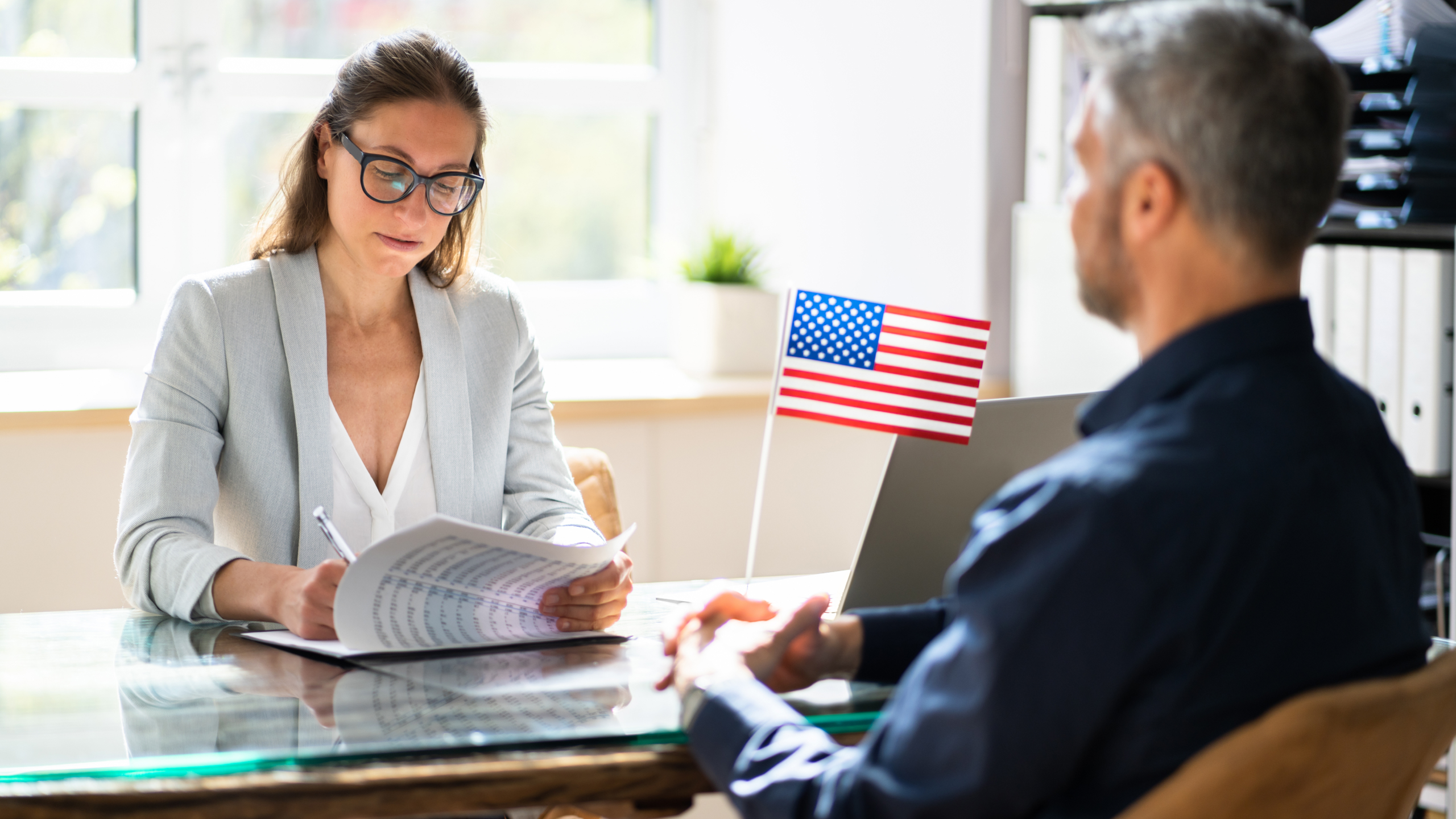What To Wear To an Immigration Interview
Is There a Dress Code?

You’ve probably prepared for your immigration interview in many ways, but did you consider what you would wear?
While your attire won’t change the outcome of your immigration case, it’s important to dress appropriately. Here’s what you need to know about dressing for your immigration interview, including information about religious garments and casual business dress code in the United States.
Do Immigration Interviews Have a Dress Code?
There is no official dress code for an immigration interview. You’re technically allowed to wear whatever you want. USCIS officers are not allowed to judge you based on what you wear to your interview. If you have already attended meetings with USCIS in jeans and a T-shirt, you have nothing to worry about.
You’re free to wear whatever you want in the United States, but it’s best to use that freedom wisely. You can fully control what you wear, but you can’t always control people’s reactions to the clothing you choose. Picking the right outfit for your immigration interview will show USCIS officers that you respect the process and take your interview seriously.
How Can I Make a Good First Impression?
How you dress for your immigration interview is unlikely to impact the outcome of your immigration case meaningfully. USCIS isn’t interested in judging you based on your appearance. They’re more interested in your background and the information you’ve included on your forms.
While how you dress won’t play a direct role in deciding your case, it can change how your interview will go. If you seem nervous or unsure of yourself, USCIS may second guess your answers or request more information. If you’re dressed nicely, you’re more likely to feel comfortable and confident.
It’s natural to feel nervous before an important interview, but choosing an outfit that makes you feel presentable and comfortable can make it a little easier to relax.
Understanding Cultural Differences in Attire
Many people don’t know what to wear to an immigration interview because of cultural differences between the culture of their home country and the United States. This can lead to people coming to their immigration interview over-prepared or under-prepared.
In some cultures, formal attire is a sign of respect. It’s true that you want the person conducting your immigration interview to understand that you respect their authority, but the United States has a different interpretation of respect.
A formal business suit would be considered overdressing for the occasion, but it isn’t entirely inappropriate. You won’t be turned away if you show up in a business suit. You’ll simply look a little out of place.
An immigration interview is treated like a business meeting. You’re coming to speak to a professional about an important process. You should both be dressed similarly.
What Is Business Casual?
People who work for USCIS dress in a style that Americans call business casual. It’s not as formal as a full suit, but it’s more professional than the normal clothes you wear to go shopping or visit your family.
Every country has its own customs for business and formality. In the U.S., business casual is a style of dress that prioritizes looking neat, clean, and professional without sacrificing comfort.
Most garments that wouldn’t be considered streetwear but are too casual to be considered full formal wear would be called business casual, like:
- Closed toed shoes
- Slacks
- Khakis
- Blouses
- Button-down shirts
- Polo shirts (shirts with collars)
- Knee-length to floor-length skirts or dresses
Optional business casual pieces include:
- A casual tie
- A belt
- A blazer (sport coat, business jacket)
- A watch
Most business casual outfits are three pieces: a suitable top, a suitable bottom, and a nice pair of shoes. Accessories or coats aren’t necessary. If the weather is very hot, it’s okay to skip blazers or jackets. If it’s cold outside, it’s acceptable to wear a nice jacket or coat that’s appropriate for the weather.
What Should I Not Wear to an Immigration Interview?
Anything you would wear to the beach, to go have a drink with your friends, to work out at the gym, or to a sporting event wouldn’t be an outfit you should wear to your immigration interview.
- Jeans or denim pants
- Excessive jewelry (wedding rings, earrings, and one or two additional pieces of jewelry are fine)
- Athletic pants
- Athletic footwear
- Tank tops (vests or jumpers)
- Coveralls
- Work uniforms
- Shorts
- Skirts above the knee
- Low-cut tops (tops that expose the upper portion of the chest)
- Jerseys or sport shirts
- Flannel shirts
- Open-toed sandals (flip flops or thongs)
- Sweatpants (joggers)
- T-shirts with logos, images, words, or graphics printed on them
- Hats or head coverings (unless they have a religious or spiritual purpose)
- Hooded sweatshirts
- Garments with distracting prints or colors
- Tuxedos or gowns
Most Americans wear these garments in their everyday lives. Some of these garments are acceptable attire for work, depending on your job. They’re perfectly acceptable for any occasion that isn’t a formal meeting or a business scenario.
What About Religious Garments?
Many religious garments don’t fit the description of business casual attire, but that doesn’t mean you can’t wear them to an immigration interview. If you’re applying for a visa as a religious worker, USCIS will likely expect you to arrive in religious garments.
If your religious or spiritual beliefs require you to wear specific garments, you are permitted to wear them to your USCIS interview. The United States recognizes freedom of religion. If you must follow specific garment rules or wear specific traditional headwear, like a hijab, thwab, kaffiyeh, yarmulke, rekel, or shtreimel, you can wear it on any occasion. You’re protected from religious discrimination in the United States.
If you’d like to adjust your religious garments to fit a business casual dress code, choose neutral colors like brown, black, tan, or gray and avoid distracting prints. You’ll be combining your religious traditions with United States customs.
Dress and Gender Identity
You are allowed to wear any business casual garments that you’d like. Attire isn’t specific to your biological sex. If you identify as female, you can wear traditionally feminine garments. If you identify as male, you can wear traditionally male garments. There shouldn’t be an issue as long as your outfit fits the appropriate dress code.
This is true even if your gender identity isn’t different from your biological sex. For example, if you are a woman who simply feels more comfortable wearing masculine business casual attire, you’re free to do so.
Dressing for Cold Weather
If it’s cold at the time of your immigration interview, business casual changes a little. If you need to wear a heavy, warm coat over your outfit, you can do so. It’s customary to remove your coat when your interview begins, but if you’re still cold in the immigration office, you can leave it on.
Most people contend with the cold by wearing layers underneath their business casual outfit. Women wear fleece-lined leggings underneath skirts, dresses, or pants to help retain body heat. Men often wear thermal underwear. Most people choose garments made of thick, heavy material that will help to keep them warm.
What If I Can’t Afford a Business Casual Outfit To Wear to My Immigration Interview?
If your immigration interview relates to asylum status, VAWA, a U-visa, or temporary protected status, the person interviewing you is aware that you’re disadvantaged. Many people seeking asylum or temporary protected status have lost much of what they own.
Your interviewer will expect you to come as you are. As long as you present yourself as cleanly and neatly as possible, USCIS won’t hold against you that you don’t have a nice outfit.
If you can’t afford a business casual outfit because nice clothing tends to be expensive in the United States, you don’t need to buy a new outfit. American thrift stores sell high-quality second hand garments in very good condition. You can likely find a business casual outfit at a thrift store for less than $20 USD. You only need a button-down shirt or blouse, pants, and shoes.
You can wear the same outfit to formal occasions and job interviews, stretching your investment even further.
In Conclusion: Your Outfit Matters, But It Isn’t the Most Important Factor
Dressing appropriately is a sign of respect. You might also feel more comfortable at your interview if you’re dressed appropriately. Dressing similarly to the people who work in the USCIS office may help you feel like you fit in with your environment.
Although your outfit is important, it isn’t nearly as important as arriving at your interview on time, prepared, and ready to provide honest answers to the questions you’ll be asked during your immigration interview. Take time to prepare and dress in a way that makes you feel comfortable.
Sources
The Role of Self-Concept on Clothing Decisions | Utah Education Network
Religious clothing and personal appearance in India | Pew Research Center
The New Rules of Work Clothes | Harvard Business Review
Thrifting: a pandemic-inspired trend that’s here to stay | Business | communitynews.org
Not sure which option is right for you? Request a confidential consultation today.

